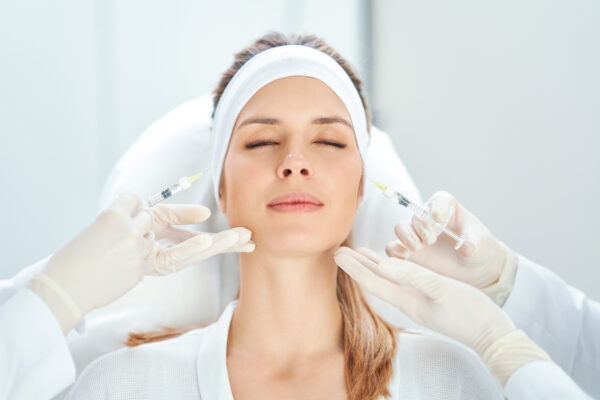Botox for Cosmetic Purposes: Tips for a Younger Appearance


Botulinum toxin is a neurotoxin used to temporarily paralyze muscles after being injected into the affected area.
This cosmetic treatment has swept the beauty industry because it is a safe, effective way to get younger-looking skin without surgery. To fully understand the benefits and drawbacks of Botox before jumping on the bandwagon, one must first learn what areas can be treated. When you search for a trustworthy clinic to administer your next round of Botox, we’ll cover all the bases in this piece.
How do you define Botox?
The active ingredient, botulinum toxin, is a neurotoxin that can be injected into muscles to temporarily paralyze them.
Wrinkles and fine lines on the face are one of the most common aesthetic concerns treated with Botox. It prevents wrinkles from forming or deepening by stopping the nerve signals that normally cause facial muscles to contract.
Botox is used for more than just cosmetic purposes; it is also effective in treating medical conditions like chronic migraines, muscle spasms, and hyperhidrosis (excessive sweating).
Botox may seem like a magic bullet for getting younger-looking skin, but it comes with a host of potential complications. These can range from temporary bruising at injection sites to permanent drooping of the eyelids in extreme cases.
What is the mechanism of action of Botox?
Botox is a neurotoxin, so it blocks nerve impulses that would normally travel to and from the muscles. When injected into targeted areas, it weakens or temporarily paralyzes the facial muscles that create wrinkles.
Injections are quick and easy procedures that can be done in a pinch. Using extremely thin needles, Botox solution is injected into problem areas. No recovery time is necessary, and the procedure can be finished in under 15 minutes.
Two days after treatment, most patients will notice an improvement, with the full effect showing up between one and two weeks later. The average length of time between Botox treatments is three to six months.
You can only get rid of dynamic wrinkles (like frown lines) with Botox, which is caused by contracting muscles. Sun damage and a general lack of elasticity in the skin are not addressed.
Botox injections carry the same risks as any other medical procedure. Occasionally, you may experience flu-like symptoms, bruising at the injection site, or droopy eyelids.
What parts of the body can get Botox?

If you have seen a horizontal frown line across your forehead, Botox injections are a fantastic option.
The use of Botox for its anti-wrinkle and anti-aging effects is growing in popularity. It is typically applied to the areas of the face that show the first signs of aging (wrinkles, fine lines, and sagging skin). The most common Botox injection sites are listed below.
Forehead Lines: Botox injections are a good solution for those horizontal lines that have appeared across your forehead. Botox, by relaxing the underlying muscles, can eliminate the creases and stop them from further deepening as time passes.
Crow’s Feet: Those fine lines and wrinkles at the outer corners of your eyes can be a dead giveaway of your age or a sign that you’ve been under a lot of stress recently. As a result of Botox’s muscle-relaxing effects, wrinkles around the injected area appear less pronounced.
Frown Lines (Glabellar Lines): These furrows between the brows can give the impression of anger or sadness even when you don’t feel that way. Botox reduces the appearance of frown lines by paralyzing the underlying muscles in this area.
Lip Lines: Botox is effective in treating smoker’s lines and “barcode lines” above the upper lips because it relaxes the muscles in that area, reducing the amount of creasing that occurs when pursing.
What is the price of Botox?
When deciding whether or not to get Botox, cost is naturally a major consideration. Botox costs can differ depending on where you live, the level of experience and skill of your provider, and the number of units you require.
Usually, you can expect to pay between $10 and $15 for one unit of Botox. However, as opposed to charging per unit used, the majority of providers bill by area treated. For instance, 10–20 units may be needed to treat forehead lines, whereas 5–15 units may be needed to treat each side of crow’s feet.
The number of target locations is also a factor in the final price. One area, such as the forehead or crow’s feet, may cost $150–$300 to treat, while treating multiple areas may cost $1,000 or more.
How do you locate a trustworthy Botox provider?
It’s in your best interest to do some research into your options before settling on a service. Verify that they have the appropriate licensing or certification. The injector’s track record with Botox is also something to think about.
Referrals from friends and family can also be useful. If you or someone you know has had good luck with Botox, you can ask them to recommend a reliable medical professional.
Botox can make wrinkles less noticeable and give the appearance of a more youthful appearance when administered correctly. Only after carefully weighing the potential advantages and disadvantages should treatment be initiated. It is recommended that you seek out a qualified medical professional who has experience injecting Botox into the desired areas.
When deciding whether or not to get Botox for cosmetic reasons, it’s important to give serious thought to all of the pros and cons. Individuals can make an educated decision about whether or not to undergo a cosmetic procedure like Botox injections by learning about the procedure’s efficacy, the areas it can treat, the risks involved, and the providers they can trust.
Dentox teaches professionals in the fields of medicine and cosmetics how to deliver Botox in an efficient and secure manner. You have the option of enrolling in a class at any of our many accessible sites across the United States, or you can study with us online in real-time or at your own speed. You may find information regarding our live courses at https://dentox.com/live-courses/, and information regarding our virtual courses can be found at https://dentox.com/all-courses/botox-training.
Injecting Botox: Can LPNs Do It?


LPNs provide assistance with a variety of patient care activities, such as assessments, medication administration, vital sign monitoring, and basic patient care.
Do you want to know if LPNs can administer Botox? Find out what LPNs can do and what they’re responsible for when it comes to administering Botox. Let’s investigate the exciting connection between health and beauty!
Practice Areas for LPNs
LPNs are involved in a wide variety of patient care activities, such as assisting with assessments, medication administration, vital sign monitoring, and basic patient care. Hospitals, nursing homes, clinics, and even in-home care are just some of the places they put their skills to use. LPNs play a crucial role in patient care, often serving as the first point of contact for those in need of medical attention.
However, it is essential that LPNs understand and adhere to the standards of their profession. While the specific laws and regulations that govern licensed practical nursing (LPN) vary from one jurisdiction to the next, all LPNs are required to report to and work under the direct supervision of an RN or other appropriately licensed healthcare professional. Patients benefit from comprehensive and coordinated care thanks to this team-based approach. The state’s laws and regulations governing nurses set limits on a licensed practical nurse’s (LPN) scope of practice.
LPNs’ scope of practice includes the administration of medication. It’s true that LPNs can give patients medication, but the drugs they can give and how they can give it might be restricted. It is common practice for registered nurses to handle the administration of intravenous (IV) medications, while licensed practical nurses (LPNs) may be responsible for the administration of oral and some injection medications. LPNs must have a complete understanding of medication safety protocols and should always look for further explanation or assistance if they feel they need it.
Educating and advocating for patients is another important duty of LPNs. Patients and their loved ones benefit greatly from the education they receive regarding their medical conditions, treatments, and self-care. By liaising between patients and other medical staff, LPNs can make sure patients’ needs and concerns are heard and met. Better health outcomes and patient satisfaction are the results of tailoring care to each person.
State-Specific Regulations
It is important for people in the United States to understand that licensed practical nurses (LPNs) have different duties and restrictions depending on the state in which they work. Thanks to the state-level regulatory frameworks in place, licensed practical nurses (LPNs) provide safe and effective healthcare.
The scope of practice for licensed practical nurses (LPNs) can vary depending on a number of factors, such as the tasks and procedures they are permitted to perform, the extent to which they need to be supervised, and whether or not they need to obtain additional certifications or specialized training.
Regulators from the state government are heavily involved in regulating and supervising LPN practice. These groups, which can include state boards of nursing, are responsible for establishing and enforcing guidelines for LPN practice. They are in charge of the granting and renewal of LPN licenses, the establishment of educational prerequisites, and the handling of complaints regarding breaches of professional conduct.
It is imperative that LPNs investigate and comprehend state-specific regulations, especially when it comes to administering treatments like Botox. Different states have different requirements for licensed practical nurses (LPNs), including the types of treatments they can administer, the minimum amount of supervision needed, and any necessary certifications or training. To ensure legal and ethical practice, LPNs should study the rules and guidelines established by their state carefully.
Contacting your state’s medical board is your best bet for getting up-to-the-minute details. Visit https://dentox.com/medical-dental-and-nursing-state-boards/ to find the appropriate medical board in your state and their contact information.
LPNs and the Botox Industry: A Role Analysis

A patient’s care and outcomes will improve when a licensed practical nurse (LPN) is involved in Botox treatments.
Having a licensed practical nurse (LPN) involved in Botox treatments is beneficial for both the patient’s care and the patient’s outcomes.
Possible Roles of LPNs in Botox Treatment:
- Patient Assessment: LPNs can assist with Botox treatment patient assessment. Interviews, medical history, and procedure suitability evaluations may be done. This evaluation aids in determining whether or not the patient is a good candidate for Botox and ensures that expectations are realistic.
- Preparing the Treatment Area: LPNs may prepare the Botox treatment area. Aseptic technique, sterilizing the injection site, and organizing supplies and equipment are required. LPNs improve treatment safety and efficiency by keeping the environment clean.
- Assisting with the Procedure: LPNs can assist MDs and NPs with Botox injections. They may use instruments or support the patient’s skin. Their presence ensures a smooth and well-coordinated procedure, improving patient satisfaction.
- Patient Education and Follow-Up: LPNs educate patients before and after Botox. They can answer questions about the procedure, side effects, and aftercare. Licensed practical nurses aid patients in arranging follow-up appointments, tracking their progress, and voicing any concerns they may have.
LPN Duties and Responsibilities During Botox Procedures:
- Assessing patients at the outset and making notes about what was found.
- Making sure everything is clean and in order in the treatment room.
- Providing necessary assistance to medical personnel during the procedure.
- Keeping a close eye on the patient throughout the treatment and afterward in case of any complications.
- Instructing patients on the procedure, possible outcomes, and aftercare guidelines.
- Noting dosage, injection sites, and other pertinent treatment notes.
- Working in tandem with other medical experts to guarantee the best possible care for patients.
Specialized Training and Certification
The ability of licensed practical nurses (LPNs) to administer Botox can be improved through participation in specialized training and certification programs. As a whole, LPNs are in a prime position to perform Botox treatments due to their specialized training and certification. Dentox can provide you with the training you need to boost both the standard of care you provide to patients and the financial health of your practice. Botox training is offered both online (at https://dentox.com/all-courses/botox-training/) and in person (at https://dentox.com/live-courses/) with real patients.
A study from the University of Queensland: Botox could be a lifesaver


Prof. Meunier explained that Botox was initially created to treat strabismus in the eyes, but it now treats migraines, chronic pain, and spasticity.
What the public knows about Botox comes from photos of the emotionless faces of the rich and famous; nevertheless, a new study from the University of Queensland suggests that Botox may actually save a life.
The mechanism through which Botox, a medication derived from lethal biological material, reaches brain cells has been discovered by researchers at the University of Queensland.
The molecular mechanism through which Botulinum neurotoxin type-A, more commonly known as Botox, enters neurons has been discovered by researchers Professor Frederic Meunier and Dr. Merja Joensuu of the University of Queensland.
For example, Professor Meunier stated, “By applying super-resolution microscopy, we were able to demonstrate that a receptor called synaptotagmin 1 binds to two other well-characterized clostridial neurotoxin receptors to form a minute complex that sits on the plasma membrane of neurons.”
“Synaptic vesicles, which contain neurotransmitters necessary for proper neuronal communication, are invaded by the toxin after it has successfully hijacked this complex.”
“Botox interferes with the communication between nerves and muscle cells, resulting in paralysis.”
A successful botulism treatment
As a result of this discovery, new pharmaceutical targets for the treatment of botulism can be sought. Botulism is a rare but potentially fatal bacterial infection.
“By blocking connections between any two of the three receptors, we may prevent the deadly poisons from entering neurons and thereby reverse our discovery that this complex allows for toxin internalization.” Prof. Meunier remarked.
Botox was first created as a treatment for strabismus in the eyes, but it has now been discovered to be effective against migraines, chronic pain, and spasticity disorders as well.
It is now well-known as a wrinkle-smoothing cosmetic treatment and is commonly used in plastic operations. In addition, it is regularly utilized in plastic surgeries.
The muscle-relaxing effects of the neurotoxin
Dr. Joensuu said that in the past, it had been challenging to identify the specific mechanism by which the toxin worked to relax the muscles.
Dr. Joensuu claims that clostridial neurotoxins are among the most powerful protein toxins associated with humans.
“At this point, we have a comprehensive understanding of the mechanisms by which these toxins are taken up by neurons and cause intoxication at amounts that are important from a therapeutic standpoint.”
Dentox helps medical and cosmetic practitioners learn how to administer Botox effectively and safely. You can enroll in a seminar at any one of our many convenient U.S. locations, or study with us online in real-time or at your own pace. Our live courses can be found at https://dentox.com/live-courses/ and our virtual courses can be found at https://dentox.com/all-courses/botox-training.
Kim Kardashian reveals in a new video that she had Botox injections in a very specific spot on her body

Kim Kardashian, queen of reality television, said in a sneak peek at the upcoming season of The Kardashians that she received the non-surgical Botox surgery while undergoing vocal training.

In the most recent episode of “Keeping Up with the Kardashians,” Kim Kardashian revealed that she has undergone cosmetic procedures.
Kim Kardashian admitted that she has had cosmetic procedures in the most recent episode of Keeping Up with the Kardashians.
During an episode of the popular reality TV show, the reality star discussed the peculiar place where she gets her Botox injections.
On Tuesday, the 42-year-old actress shared a scene from the most recent season through Snapchat (May 23). In the film, she alluded to the upcoming conflict between the famous sisters.
Towards the end of the video, there is a brief scene in which Kim engages in conversation with a voice coach as the sisters embark on a new endeavor.
This is what the voiceover said: “We are currently working on the recording of an album. It is a requirement of ours to participate in singing classes.”
After that, the video showed Kim as she was taking a lesson, and her voice coach explained: “The muscles in my neck are getting a workout.”
Then Kim responded by stating, “The other half of mine have presumably been treated with Botox, so I can’t, like…”
After admitting she wants to take her time finding a new partner so she doesn’t repeat the “same mistakes” she’s made in the past, the star’s comments come as no surprise.
Kim has been dating nobody since she and Pete Davidson broke up in August of 2022, but she says she’ll always be a “hopeless romantic.”
On the latest episode of the On Purpose With Jay Shetty podcast, the developer of SKIMS mentioned that, as a mother of four, she has to consider “several aspects” before getting involved with someone new.
“I think there are so many factors, especially when you have kids and are conscious of individuals that enter your life, so I’m going to take my time,” Kim said when questioned about her plan to take things slowly.
She continued, “I just believe it needs to be different for me if I can look at everything I did incorrectly and try not to repeat the same mistakes while taking my time.”
“I think that I will always be a hopeless romantic, someone, who longs for love and who finds great joy in sharing and building a life with another person.”
The actress, who has been married three times previously, claims she is not currently seeking love and has kept herself busy to avoid feeling lonely.
Improve the quality of your patient’s lives by mastering new skills that will help them look and feel better. If you have the proper education, your patients will profit from your expertise. Visit https://dentox.com/live-courses/ and https://dentox.com/botox-training/ to find out about online and in-person patient training events, respectively.
A San Jose couple is being investigated for allegedly running a botched Botox business


A San Jose couple charged consumers tens of thousands of dollars for non-medical services including Botox injections and lip fillers without a medical license.
After a little more than a month had passed since a woman passed away after receiving buttock injections in a Burlingame hotel room, a San Jose couple has been charged with felony offenses for allegedly operating an unlicensed botox business from their home. Without having a valid medical license, the couple allegedly charged customers tens of thousands of dollars for non-medical services such as Botox injections, lip fillers, and other procedures.
A 45-year-old woman with the initials M.C. claims categorically that her home was never used as an illegal medical spa.
“It was possible to consult with my attorney, but no action was taken. The search for my home yielded no results. This is untrue. They turned up zero results,” she said.
According to a Santa Clara County deputy district attorney, customers were tricked into thinking the company was legitimate. She has filed multiple felony charges against M.C. and her 48-year-old partner with the initials J.C. for practicing medicine without a license.
They are anatomically illiterate. They could inject it into a vein, and it would eventually reach the brain or the heart, where it would be fatal.
It all started when a patient became suspicious because she kept getting the runaround when she asked for licensing information. The lack of a license was something the patient discovered on her own.
A dentist later revealed that an unauthorized individual had attempted to purchase Botox with her digital signature. J.C. was the man in question.
She is well aware of the underground market for Botox due to the desire of all women to look their best. Just be cautious.
The Deputy District Attorney has stressed the importance of only hiring those who are properly trained and licensed.
And M.C. maintains that she did not administer Botox injections to female patients, despite what the D.A. claims.
She said, “There are erroneous accusations. I’ve been the target of hostility from a physician.”
The Dentox program educates medical and aesthetic professionals on how to administer Botox with precision and efficiency. Dentox can help you get a first-rate education so that you can better serve your patients and expand your business.
Dr. Howard Katz is widely recognized as a leading expert in the field of injectable education. In addition to teaching his courses in a conventional classroom setting, he also makes them available online and on demand. For online Botox training, visit https://dentox.com/all-courses/botox-training/, and for live training with actual patients, visit https://dentox.com/live-courses/.
Non-surgical Cosmetic Procedures: Investigating a Facelift Training Course in Liverpool


In a documentary, it is shown how risky one-day courses and the internet are used to teach complicated beauty procedures that involve needles and surgical threads.
During an undercover video of a non-surgical facelift training course, the patient’s blood vessels were accidentally punctured because the trainer didn’t always follow the same hygiene rules.
When experts looked at the video, they worried that the students in the course might one day pose a threat to public safety.
Three non-surgical cosmetic procedures: fillers, microblading, and botox
Botox, microneedling, and thread lifts are all non-invasive cosmetic procedures that have become more and more popular in recent years.
There has also been an increase in the number of schools that teach people how to give these kinds of therapies.
However, there is little oversight of aesthetics-related training programs.
Even though some cosmetic procedures involve needles and can cause serious problems, the government does not require a practitioner to have any special training or certification.
Getting certified is as simple as enrolling in a training course.
Aesthetics training programs vary greatly in quality because there is no agreed-upon standard.
We were able to find 26 different cosmetic training schools in Liverpool. Their prices ranged from £150 to $5,000.
There was a wide range in length for these classes, from a few hours online to several days in a classroom setting.
We dispatched an undercover nurse to a nursing school in Liverpool back in April.
At a special training course, the nurse learned how to do a facelift without cutting into the skin. This was done with surgical threads. The term “thread lift” is sometimes used to describe the procedure.
This method uses a thread that is very similar to the kind used to close wounds after surgery.
The thread is inserted under the skin with a needle and then drawn upwards to give the appearance of a facelift.
A thread lift is the most dangerous procedure an aesthetic practitioner can do.
Far more so than with any other injectable treatment, there is a high risk of complications. Because once a thread is in the skin, it stays there forever and can’t be taken out.
Even though the payoff, if there is one, could be huge, the risk of permanent damage must be taken into account.
The training academy’s thread lifting program started with five hours of theoretical instruction online, and culminated with a day of hands-on instruction in Liverpool.
In order to prevent infections during a thread lift, the operating area must be kept in a state of extreme sterility. But our spy nurse saw the tutor touch a number of things before touching the face of the patient. Because of this, the patient was more likely to get an infection that wouldn’t go away.
The leading instructor did not even bother to clean a bed, but rather did the procedure on a chair. She took calls and even asked someone else to film the procedure.
Apparently, while the patient still had the needle in her face, the trainer went ahead and posted the video clip on social media, as reported by our undercover nurse.
Also, a hidden video shows the instructor repeatedly puncturing the blood vessels of the same patient during the procedure.
Observing these patients, you could tell they were in excruciating discomfort. The local anesthetic injection was met with groans of protest.
Also, our nurse saw people smoking cigarettes and drinking alcohol before and during treatment.
Ultimately, no student would have been able to graduate with the technical or practical ability to provide safe and comprehensive care, posing an extreme risk to whoever they chose to treat.
Coming across the unchecked beauty business
Anchal, a beauty expert and makeup artist on YouTube with more than 200,000 subscribers, was one of the first people to talk about getting plastic surgery in an open way.
Anchal was sent on a microneedling treatment training course so we could observe the mechanics of such classes firsthand. In this treatment, very fine needles are put into the skin to help the body make more collagen on its own. While she is familiar with the procedure as a patient, she has never performed it herself.
Everything was done through Zoom, and all she had to do to finish the course was send in a picture of a case study she had worked on for practice.
The training session concluded after about an hour and a half.
The training consisted primarily of the instructor reading from a PowerPoint presentation about microneedling. No one showed you how to use the microneedling pen in person, and they didn’t even have one to demonstrate with.
The importance of good hygiene, the need to sterilize tools, and how to avoid getting stuck with a needle were not talked about in detail during the training.
After taking this course, it’s unlikely that students will be able to use what they’ve learned in a safe way.
If you want to try this treatment, you should only do so under the supervision of a trained professional who gives you in-person instructions.
The public at large may be profoundly affected by these classes.
If you have the right education and training, you might be able to make a big difference in your patients’ lives by helping them reach their aesthetic goals. To register for online classes, please go to https://dentox.com/all-courses/botox-training/, and to register for live patient courses, please go to https://dentox.com/live-courses/.
“To be young again?” It’s not something Victoria Beckham is interested in


If Victoria Beckham is convinced that the medical professionals giving Botox can give her a natural look, she may reconsider receiving it.
Victoria Beckham, who is soon to turn 50, recently spoke candidly about aging and time passing in an interview. Posh Spice has spilled the beans.
She is of the opinion that she would be better off without Botox.
The fashion designer, who is 49 years old, claimed that she doesn’t like the way wrinkle injections make her face look and that she’s fine with aging, so she’d rather look “rested and fresh” than undergo “scary” procedures to make herself look younger.
She said: “You frequently develop a quite shiny forehead, plus your eyebrows arch excessively. I have zero plans to reverse time. I’m 49 years old and completely fine with it.”
“I want to present a well-rested and revitalized version of myself. I think it boils down to the tiniest of details. The same goes for makeup; it’s important to avoid going overboard with it because doing so can hasten the aging process.”
“Recently, I attended a gathering where everyone’s faces appeared to be extremely ‘big’ [overfilled]. Some of the available choices are downright terrifying.”
Victoria admitted that, while she enjoys laser treatments and skin tightening, Botox isn’t for her. She emphasizes moderation in all aspects of her life.
When asked what one thing she wouldn’t do again, Victoria responded that she wouldn’t ruin her eyebrows by plucking them too much, as she did in the 2000s when it was fashionable to do so.
“My eyebrows have been plucked to the point where you would be appalled if you saw me barefaced. My eyebrows have always been here, so David has never seen me without them. As soon as I wake up in the morning, I start working on them.”
It goes without saying that David refers to her husband, David Beckham, to whom she has been married for the past 24 years.
When asked if she wanted to be 25 again, Victoria replied that she “wouldn’t want to be” because her self-esteem has only grown stronger with time.
She declared, “I am content with myself; I accept my appearance; and I do the best I can with the resources at my disposal. At 49, I’ve reached a point in my life where I feel incredibly fulfilled both personally and professionally.”
“I give careful consideration to my daily makeup routine. Yet I enjoy how it feels to be older.”
“I wouldn’t want to revert to being 25. As a young woman, I was the type to look at myself in the mirror and focus on the things that were wrong with me rather than the things that made me look good.”
“I’ve always been very critical of myself; however, that criticism has driven me to constantly improve. It’s not about being someone different; rather, it’s about admiring your finest qualities.”
“And at 49, I have better muscle tone than I did at 25.”
“Although I don’t make a point of it, I don’t believe that getting older is an excuse for not pursuing your dreams. You can still look absolutely stunning. You are now more in tune with your body and its needs. What I need to do in the gym, what I need to eat, and what works on my face are all things I now have a better understanding of. Information is power.”
It is possible that Victoria Beckham will change her mind about getting Botox if she is assured that the medical personnel performing the procedure are competent at administering Botox and will be able to give her a natural appearance rather than one that has been artificially enhanced.
Medical professionals with the appropriate training can assist people in feeling more self-assured about their appearance. Their training would give them the knowledge that would only benefit their patients.
The medical community now has access to specialized Botox training. You can register for a seminar at one of our many locations throughout the United States or enroll in a live online course or an on-demand course instead. For information on both in-person and virtual courses, see https://dentox.com/live-courses/ and https://dentox.com/all-courses/botox-training/.
Botox Injections: Which Degree Is Necessary?


Gaining a medical degree improves employment prospects for Botox injectors.
Many different educational options exist for those interested in becoming professional Botox injectors. These roads lead to the education and experience needed to become a top professional in the field. Let’s look at the various possibilities:
Medical Degrees
Botox injectors who earn medical degrees have greater employment prospects. Earning a medical degree can open doors to a wide range of rewarding careers and increase your credibility and trustworthiness in the eyes of patients and colleagues alike. To earn a degree in medicine, students must complete a lengthy and demanding academic process:
1. Undergraduate Education:
A science-related bachelor’s degree is required to apply to medical school. Majoring in biology, chemistry, or biochemistry is common among undergraduates.
2. Medical College Admission Test (MCAT):
The Medical College Admission Test (MCAT) is a standardized test given to students planning to pursue a career in medicine. Medical school acceptance rates are higher for those who perform well on the Medical College Admissions Test.
3. Medical School:
Medical school is a four-year commitment. Anatomy, physiology, pharmacology, and medical ethics are just some of the subjects typically covered in the first two years of medical school. The final two years of medical school are dedicated to clinical rotations, during which students gain practical experience in a variety of medical fields.
4. Residency Training:
To become a Botox injector, one must first finish medical school and then complete residency training in a field related to their chosen profession. Aesthetic procedure patients often seek care from dermatologists, plastic surgeons, and otolaryngologists.
5. Continuing Education and Specialization:
In order to provide the best care possible, medical professionals need to engage in lifelong learning. They can do fellowships or advanced training in aesthetic medicine to learn more about injecting Botox.

Medical personnel, in order to give the highest quality care, must commit to lifelong learning.
Nursing Degrees
A nurse’s attentiveness to patients and medical expertise complement Botox injections. Nurses play a crucial role in the healthcare team because of their many contributions, including patient education and evaluation, injection administration, follow-up care, and collaboration with medical experts.
Here are the steps to take and the credentials to have in order to become a nurse who administers Botox:
1. Nursing Education:
The first step for aspiring Botox injectors is to earn a nursing degree. Several academic tracks can help you accomplish this, such as:
- Associate in Nursing (ADN): A two-year curriculum designed to educate and train future nurses.
- Bachelor of Science in Nursing (BSN): An in-depth four-year degree with tracks in leadership, research, and community health.
- Accelerated Nursing Programs: Designed for people who already have a bachelor’s degree and want to become nurses.
2. Licenses and accreditation:
A nursing degree and successful completion of the National Council Licensure Examination for Registered Nurses (NCLEX-RN) are prerequisites for practicing nursing in the United States. There are various license requirements that can vary from state to state.
In addition to general nursing certifications, aesthetic nursing certifications, and Botox injection certifications are available to nurses. These courses are designed to improve the nurse’s proficiency in giving Botox injections by providing specialized training in this area.
Other Healthcare Degrees
The field of botox injections is not limited to those with medical or nursing degrees.
Physician Assistant (PA) Degrees
A physician assistant is a medical professional who aids doctors in patient care. They have extensive medical training and play crucial roles in many facets of healthcare, including the aesthetic realm. Here are some of the reasons why PA programs are helpful for Botox administration:
- PA programs offer a solid foundation in medical knowledge, including anatomy, pharmacology, and patient evaluation.
- PAs are educated in a variety of medical procedures, including injections.
- PAs collaborate with other medical staff, such as MDs and RNs, to give patients the best possible treatment.
Nurse Practitioner (NP) Degrees
Registered nurses who have completed additional education beyond the traditional nursing degree are known as nurse practitioners or advanced practice registered nurses (APRNs). When it comes to administering Botox injections, they have a lot to offer.
- NPs prioritize patient care. They understand patients’ needs and work with them to create personalized Botox treatment plans that meet their goals and well-being.
- Aesthetic-trained NPs can inject Botox. They can evaluate and meet each patient’s needs to ensure safe and successful outcomes.
- In many cases, NPs develop lasting bonds with their patients. This provides continuity and a better understanding of individual needs and preferences for Botox injections.
Dentistry Degrees
Dentists aren’t always the first people’s minds turn to when they think of Botox injections, but their familiarity with the human face and mouth makes them ideal candidates:
- Due to their oral health focus, dentists understand facial structures and muscles. This allows them to inject Botox precisely and in harmony with facial aesthetics.
- Many dentists offer aesthetic dentistry and facial rejuvenation. Dentists can enhance facial aesthetics with Botox injections.
- Dentists focus on patients’ oral and facial health. They can meet patients’ aesthetic needs more holistically by offering Botox injections.
Esthetics and Cosmetology Programs
When it comes to Botox injections, estheticians and cosmetologists are indispensable. They aid in the efficacy of treatments thanks to their knowledge of skin care and cosmetic procedures.
Estheticians and cosmetologists offer expertise in skincare, as well as evaluations of patients’ skin conditions and desired results, preparation of patients’ skin for Botox injections, and aftercare instructions.
Cosmetologist’s and estheticians’ educational requirements are as follows:
- Sign up for a recognized program in the field of esthetics or cosmetology.
- Obtain specialized instruction in cosmetic procedures, facial treatments, and skincare.
- Pass written and practical tests to get a license.
- Continue your education to stay current on developments in the field.
Since the regulations differ from state to state, it is important to contact the medical board in your state if you want accurate and up-to-date information. You may access the contact information for the various medical boards at the following website: https://dentox.com/medical-dental-and-nursing-state-boards/.
Finally, Botox injections require highly specialized training and certification to ensure patient safety and treatment efficacy. If you want to improve the quality of care you give your patients and the success of your business, Dentox can help you get the education you need to do both. For online Botox training, visit https://dentox.com/all-courses/botox-training/, and for live training with actual patients, visit https://dentox.com/live-courses/.
Gym TikTok’s “Trap Botox” Is a Hit


Weightlifting can lead to targeted muscle growth in desired areas, such as the glutes and legs, but may also result in unintended muscle growth, such as in the trapezius.
Botox’s off-label uses include relieving migraine pain, spasms, and bladder issues. A growing number of people, however, are discovering additional off-label applications for this injection. Most bodybuilders and athletes put a lot of time and effort into strengthening the trapezius, a muscle that runs from the top of the head to the top of the shoulders and down the upper back. However, if you feel you’ve gained too much muscle on your back or if you regularly find yourself with poor posture as a result of working at home, this can lead to a more rounded, bulky appearance than you were going for. That’s why there’s trap Botox, a treatment designed to reduce the size of the muscles in that area of the body.
Trap Botox’s Aesthetic Potential
Many women go to the gym with the intention of losing weight, getting stronger, and improving their physique without developing a “bulky” appearance. Although this is a matter of taste, there are many people whose primary goal is to pack on as much muscle as possible, making it difficult for those whose aesthetic preference is to maintain a long and lean physique. Working out with weights and increasing your muscle mass will result in gains in the areas you want to build, such as the glutes and legs, but it may also result in gains in areas you weren’t necessarily looking to bulk up, such as the trapezius.
You could stop going to the gym altogether or focus solely on cardio if you wanted to reduce the appearance and size of this muscle, but that would result in a reduction of muscle mass everywhere. Consequently, many people are having Botox injections to get rid of the extra fat around their necks and shoulders.
Medical Applications of “Trap Botox”
The benefits of controlling an overactive trapezius go beyond mere aesthetics. Stiffness and pain in the upper back and neck are common complaints among those who regularly sit with poor posture, especially those who spend their days hunched over a phone or computer. The trapezius muscle is constantly under tension and flexed in this position as it bears the brunt of the load on your head. If done frequently, it could result in lingering discomfort and even give the shoulders a more rounded appearance, a condition known as a text neck.

When injected into the trapezius, Botox can reduce stress and stiffness from muscle overuse.
Botox injections into the trapezius muscle can ease the stress and stiffness caused by the muscle’s overuse. While these injections can only provide temporary relief, they can buy you some time to focus on other strategies for enhancing your posture and reducing your reliance on this muscle.
What should you anticipate from this injection?
Locating a competent medical professional who performs shoulder injections should be your first step. Unlike Botox for the face, this one may require a bit of research to uncover. However, if you want the best results from your trapezius Botox, it’s best to find a provider who has experience with this area in particular. When you and your doctor have decided that this is the best course of action, you can then schedule a consultation to go over your goals for the injections in greater detail. They may also be able to show you before and after pictures to give you an idea of how the procedure will change your appearance.
Once you’ve done that, you can make an appointment to get your injections. Although this procedure isn’t particularly enjoyable, you shouldn’t experience any severe pain or have any recovery issues. Injections can cause pain, but icing the affected area after you get home can reduce swelling and provide temporary relief.
Do any dangers exist?
Despite the unsettling thought of willingly injecting a neurotoxin into your muscle, Botox is a relatively low-risk cosmetic procedure. Problems may arise if you visit an unqualified provider, but if you check that they maintain a clean and secure facility, you shouldn’t have any problems. It’s possible that the area around the injection site will be sore or bruised immediately after the procedure, but both of these side effects should fade over the next few days. Botox may also spread to other parts of the body and weaken or impair the function of other muscles; however, this is unlikely to be an issue if administered by a trained medical professional.
It is also possible, albeit highly unlikely, to develop an allergy to Botox. A trip to the emergency room is warranted for anyone who develops a rash, significant swelling, hives, or trouble breathing, even if such reactions are rare. The warnings should be taken seriously, however, to prevent any further damage.
What is the price of “Trap Botox”?
Your doctor’s fee structure, the average cost of medical care in your area, and the quantity of Botox you require to achieve your goals all play a role in how much your full trapezius Botox session will cost. Botox typically costs between $10 and $15 per unit, and about 50 units are injected into the trapezius muscle on each side at a total of five different points to reduce its activity. Depending on the specifics of your case, the total cost per session could be anywhere from $1,000 to $1,500 when both sides are considered.
Dentox is a course designed to educate medical professionals on the proper way to administer Botox injections. Discover cutting-edge methods for improving your patients’ well-being. Visit https://dentox.com/all-courses/botox-training/ for details on our online patient training courses, and https://dentox.com/live-courses/ for information on our in-person training sessions.
At-home Botox and filler treatments are a potentially lethal new fad


Social media sites like TikTok are making younger generations more familiar with aesthetic treatments and more confident in doing them themselves.
The popularity of administering Botox and fillers at home is on the rise. Recent data shows that demand for these therapies has skyrocketed in the wake of the pandemic, with more people opting to give themselves injections at home. Younger generations are becoming more familiar with aesthetic treatments and more confident in performing them on their own thanks to the proliferation of social media platforms like TikTok.
Regrettably, as the medical aesthetics market grows in popularity, more and more people will opt to treat themselves at home. It’s crucial to emphasize the grave risks associated with self-administering any kind of injection. Among the most serious issues brought on by this trend are listed below.
Lack of training: Due to the serious nature of Botox and filler injections, not enough people have the proper training to perform them. Vascular occlusion is just one of many potentially fatal complications that can arise from attempting to self-administer these treatments. When a substance enters a blood vessel, it can cause a clot to form, which blocks blood flow to vital organs and tissues and may lead to blindness.
Inadequate hygienic practices: In order to avoid spreading infection and other complications, it is crucial to practice good hygiene before and after administering these treatments. When people give themselves injections, they may not use properly sterilized needles or properly dispose of used needles, and they may not have access to medical-grade cleaning solutions.
Incorrect dosage and depth: Using too much or too little product can result in a number of issues, including pronounced asymmetry, facial paralysis, and droopy eyelids. A trained medical professional will know the ideal injection depth to minimize risk and maximize natural results.
Use of non-US products: Products that have received FDA approval have undergone extensive testing to ensure their efficacy and safety. People are purchasing goods from other nations over the internet, but we have no idea what is in them or how safe they are.
Adverse effects: Allergic reactions or other issues that call for medical attention can occasionally occur in patients. It’s crucial to realize that trained injectors and medical professionals can administer these treatments safely, hygienically, and successfully.
Despite the convenience of at-home Botox and fillers, it’s important to find a licensed medical expert for these treatments.
Dentox makes it easier for medical and aesthetic professionals to receive training in administering Botox injections safely and effectively. You can register for a seminar at one of the many venues spread out across the country, or you can enroll in one of our live online or on-demand courses. Please visit https://dentox.com/live-courses/ and https://dentox.com/all-courses/ to learn more about our live courses as well as our online ones.





